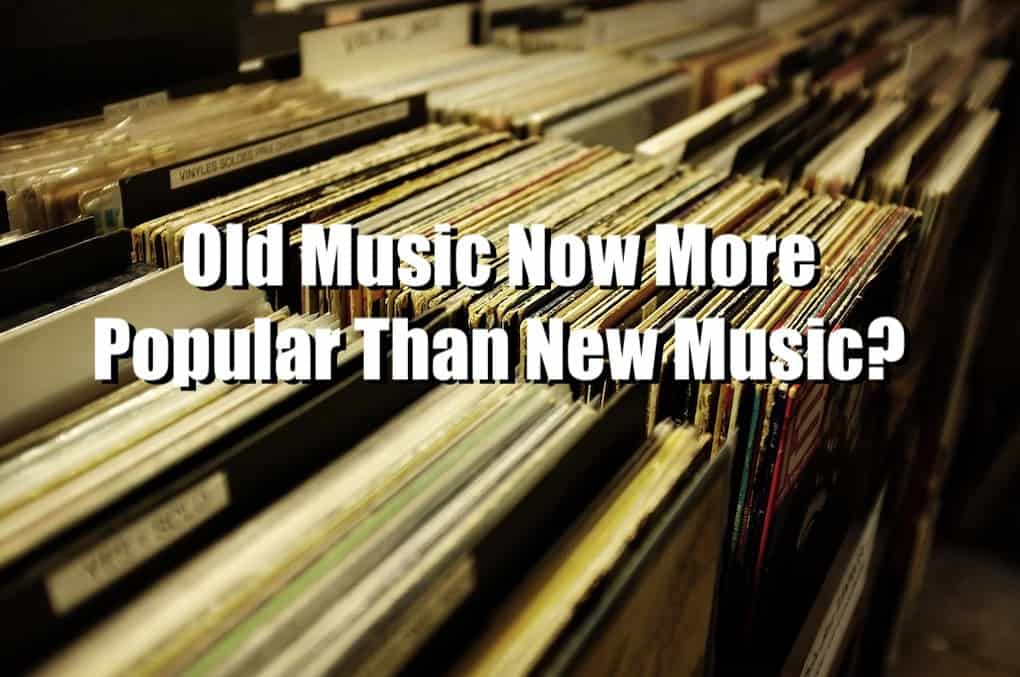Everybody loves a good oldie but goodie, but is it so much that new music is suffering? Let’s find out.
A guest post by Bobby Owsinski of Music3.0.
There’s a post written by Ted Gioia called “Is Old Music Killing New Music?” that’s sweeping through the music industry right now. It’s based on the recent report by MRC that states that more than 70% of all music consumed in the U.S. is what’s known as catalog, or older than 18 months. In many cases, it’s way older, like decades. Even more important is that old music is clearly driving the profits of the music business these days, even though the latest hits get all the hype.
There’s a lot of great data and observations in that post and it’s definitely something you should read, but I want to elaborate a bit on this trend and perhaps shed some light on why I believe we’re heading in the direction of old music dominating consumption.

Is Old Music Better?
Let’s address the elephant in the room first – is old music better than new music? In some ways yes, and other ways, no. There’s always great music being made regardless of the era, it’s just that we may never get to hear much of it these days. Record labels drive what’s popular, unfortunately, and whatever the current trend is, they want more of it. As a result, we get an exciting new trend that gets slowly watered down with weaker and weaker imitations (look what happened to hip-hop).
One of the things that drove music in the 1970s and 80s was the search to be different. Artists and labels weren’t afraid to take chances, and as a result, we had such a wide variety of great music to choose from. There were no sub-genres of music (i.e. trip-hop, death metal, etc) – it all fit under a big genre umbrella that no one really cared about.
FM radio was at its peak, and you tuned in because of the specific tastes of the DJ, who was free to spin whatever he or she liked. As a result, the listener was exposed to a wide variety of artists. Marivishnu Orchestra was played right beside Deep Purple which was right beside Gil Scott Heron or Sly Stone.
Today we’re all about niche, and even worse, algorithms that feed us more of the same thing that we just listened to rather than something totally new and different.
It’s A Little Too Easy
But the hits are what we’re most often exposed to and they’re not lighting up the earbuds of even the demographic that they’re aimed at. I think a big reason for that is the fact that songwriting has gotten lazy. Not on purpose, mind you – just because the technology makes it that way.
Why practice your instrument, try to form a band, or learn how to record when all you have to do is find a beat or loop that you like and build the song from there? That’s not to say there hasn’t been some great songs that came about that way, but a loop is a limiting factor in songwriting as it encourages simple two chord songs with an even simpler melody. Plus add the fact that there’s 10 or more writers on some songs and you have the lowest common denominator in songwriting that’s almost guaranteed not to take chances.
This gets rewarded and encourages others to write this way, and what we have today is the result.
The Attraction Of Old Music
Again, old music isn’t necessarily better, but there are a few things that the hits of yesteryear have that many new hits don’t today.
Adventurous chord patterns, for one. In songs before around 201, sometimes a bridge or a chorus would jump to a place you never might imagined (Bowie’s “Life On Mars” or Elton John’s “I Guess Why They Call It The Blues” for example). You don’t get that chance when you’re writing to a loop because you’re automatically restricted to the chord in the loop.
Energy, for another. A loop or beat captures one moment of energy time that repeats over and over. A song with a real rhythm section breathes in intensity with the track as the energy flows just like life – up and down, tension and release. I hate to refer to songs better visited by a way-back machine, but a great example is “Refugee” by Tom Petty and The Heartbreakers, or “All Night Long” by Lionel Ritchie (especially the outro after the bridge).
Modern music production has squeezed much of that primal energy out of music by adding or subtracting mix elements over a static rhythm section to add and subtract energy rather than changing the intensity of the playing, but to be fair, that started way before what we’re going through today.
Trends Change
One thing’s for sure is that music is going to evolve and change, as it always does. There’s going to be a new artist that will use what’s currently available and meld it with that of the past (like real musicians) and then the new trend will be off and running.
Production with loops and beats might become passe as bands become the in-thing again. Songwriters will try something other than just 1-4-5 chord structure (we can only hope) and try to push the envelope with chord changes, song form, and melody jumps. We’re only a hit away from that happening.
In the meantime, it’s up to every listener to dig deep to find the greatness that’s already out there, while still enjoying the old music that we’ve already heard.
Bobby Owsinski is a producer/engineer, author and coach. He has authored 24 books on recording, music, the music business and social media.
Read more: https://music3point0.com/2022/01/21/the-reasons-old-music-is-now-more-popular-than-new-music/#ixzz7IhpbOCtg
Under Creative Commons License: Attribution Non-Commercial Share Alike





























